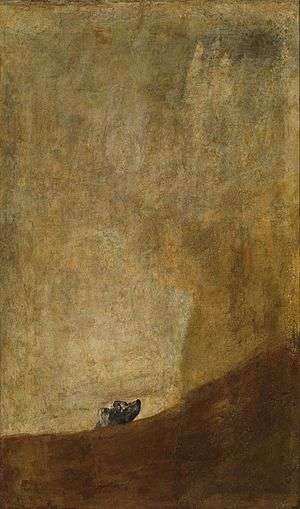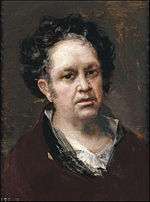The Dog (Goya)
 | |
| Artist | Francisco Goya |
|---|---|
| Year | circa 1819–1823 |
| Type | Oil mural on plaster transferred to canvas |
| Dimensions | 131.5 cm × 79.3 cm ( 51 3⁄4 in × 31 1⁄4 in) |
| Location | Museo del Prado, Madrid |
The Dog is the name usually given to a painting by Spanish artist Francisco Goya, now in the Museo del Prado, Madrid. It shows the head of a small black dog gazing upwards. The dog itself is almost lost in the vastness of the rest of the image, which is empty except for a dark sloping area near the bottom of the picture: an unidentifiable mass which conceals the animal's body.
The Dog is one of the Black Paintings Goya painted directly onto the walls of his house sometime between 1819 and 1823. He did not intend the paintings for public exhibition (they were not removed from the house until 50 years after Goya had left), so it is unlikely that he gave them titles.
Background
In 1819, Goya purchased a house named "Quinta del Sordo" ("Villa of the Deaf Man") on the banks of the Manzanares near Madrid. It was a small two-story house which was named after a previous occupant who had been deaf,[1] though Goya also happened to be functionally deaf, as a result of an illness he had contracted (probably lead poisoning) in 1792. Between 1819 and 1823, when he moved to Bordeaux, Goya produced a series of 14 works, which he painted with oils directly onto the walls of the house. At the age of 73, and having survived two life-threatening illnesses, Goya was likely to have been concerned with his own mortality, and was increasingly embittered by the conflicts that had engulfed Spain in the decade preceding his move to the Quinta del Sordo, and the developing civil strife–indeed, Goya was completing the plates that formed his series The Disasters of War during this period. Although he initially decorated the rooms of the house with more inspiring images, in time he overpainted all of them with the intense haunting pictures known today as the Black Paintings. Uncommissioned and never meant for public display, these pictures reflect his darkening mood, with their depictions of intense scenes of malevolence, conflict and despair.
If Goya gave titles to the works he produced at the Quinta del Sordo he never revealed what they were; the names by which they are now known were assigned by others after his death, and this painting is often identified by variations on the common title: A Dog, Head of a Dog, The Buried Dog, The Half-Drowned Dog, The Half-Submerged Dog; more colloquially as "Goya's Dog"; or by the Spanish names El Perro or Perro Semihundido.
Painting
The painting is divided into two unequal sections: an upper, dirty ochre "sky" and a smaller sloping curved dark brown section which fades to black as it slopes up to the right. Over the top of this lower section the dog's head can be seen, its snout lifted, its ears pulled back and its eyes looking up and towards the right. A faint dark shape looms over the dog; this is sometimes considered to be damage or an intentional inclusion, but is generally seen as an artefact from the earlier painting that decorated the wall before Goya overpainted it with The Dog.
The enigmatic depiction of the dog has led to myriad interpretations of Goya's intentions. The painting is often seen a symbolic depiction of man's futile struggle against malevolent forces; the black sloping mass which envelopes the dog is imagined to be quicksand, earth or some other material in which the dog has become buried. Having struggled unsuccessfully to free itself, it can now do nothing but look skywards hoping for a divine intervention that will never come.[2] The vast swathe of "sky" which makes up the bulk of the picture intensifies the feeling of the dog's isolation and the hopelessness of its situation. Others see the dog as cautiously raising its head above the black mass, afraid of something outside the painting's field of view, or perhaps an image of abandonment, loneliness and neglect. Robert Hughes says "We do not know what it means, but its pathos moves us on a level below narrative."[3]
Influence

Caspar David Friedrich's The Monk by the Sea (Mönch am Meer) painted around 1808–1809 is on a similar theme: a tiny figure dwarfed by a featureless landscape, but Goya's work goes further in breaking with traditional composition. While Friedrich's subject is dwarfed by its surroundings – the monk takes up an even smaller proportion of the canvas than Goya's dog – the landscape is recognisable as a landscape and the lines conventional.[4] Goya's influence is apparent in the dog in Pierre Bonnard's 1910 The Red-Checkered Tablecloth, although the mood of Bonnard's cheerfully unambiguous painting is directly opposite to Goya's portentously obscure piece. [2]
Transfer from the Quinta del Sordo

Although never meant to be seen by the public, the paintings were obviously important works in Goya's oeuvre. When Goya went into self-imposed exile in France in 1823, he passed the Quinta del Sordo to his grandson, Mariano. After various changes of ownership, the house came into the possession of the Belgian banker Baron Emile d'Erlanger in 1874. After 70 years on the walls of the Quinta del Sordo, the murals were deteriorating badly and, in order to preserve them, the new owner of the house had them transferred to canvas under the direction of Salvador Martínez Cubells, the curator of the Museo del Prado.
After showing them at the Exposition Universelle of 1878 in Paris, d'Erlanger eventually donated them to the Spanish state. The effects of time on the murals, coupled with the inevitable damage caused by the delicate operation of mounting the crumbling plaster on canvas, meant that most of the murals required restoration work and some detail may have been lost. The Dog appears not to have suffered too badly, though the faint dark shape in the upper right of the picture is sometimes considered to be damage. The Dog was on the second floor of the Quinta del Sordo, and in disputes over the provenance of the Black Paintings exchanges have focused on whether the villa possessed a second floor at the time of Goya's residence.
Reception
Goya was long dead by the time the paintings were first exhibited publicly. Spanish painter Antonio Saura thought The Dog "the world's most beautiful picture",[5] and his contemporary, Rafael Canogar referred to it as a "visual poem" and cited it as the first Symbolist painting of the Western world. Picasso was a great admirer of the Black Paintings (though he did not single out the The Dog in particular), and Joan Miró requested to see two paintings on his final visit to the Prado: The Dog and Velázquez's Las Meninas, which he held in equal regard. Manuela Mena, curator at the Prado, claimed: "There is not a single contemporary painter in the world that does not pray in front of The Dog".
Notes
References
- Connell, Evan (2004). Francisco Goya: A Life. Counterpoint. p. 256. ISBN 978-1-58243-307-3.
- Hagen, Rose-Marie and Rainer Hagen (2003). Francisco Goya, 1746–1828. Basic Art Series. Taschen. ISBN 3-8228-1823-2.
- Hughes, Robert (October 4, 2003). "The unflinching eye". The Guardian. Retrieved June 26, 2009.
- Hughes, Robert (2004). Goya. New York: Alfred A. Knopf. ISBN 0-394-58028-1.
- Lubbock, Tom (July 11, 2008). "Goya, Francisco de: The Dog (c1820)". The Independent. Retrieved June 26, 2009.
- Solemne acto de apertura del curso 1997–98 y de investidura como doctor "Honoris Causa" del Excmo. Sr. D. Antonio Saura. Universidad de Castilla-La Mancha. 1997. p. 81.
- Imaginary Portrait of Goya 1966. Tate. Retrieved June 26, 2009.
External links
